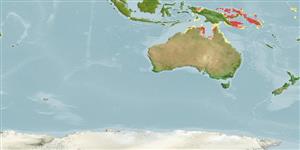>
Ovalentaria/misc (Various families in series Ovalentaria) >
Pomacentridae (Damselfishes) > Pomacentrinae
Etymology: Amphiprion: Greek, amphi = on both sides + Greek, prion, -onos = saw (Ref. 45335).
Environment: milieu / climate zone / depth range / distribution range
Ekologi
marina revassocierade; ej vandrande; djupintervall 2 - 12 m (Ref. 9710). Tropical; 1°S - 25°S
Western Central Pacific: Papua New Guinea, Manus Islands, D'Entreceasteaux Islands, New Britain, and Solomon Islands.
Size / Vikt / Age
Maturity: Lm ? range ? - ? cm
Max length : 12.0 cm TL hane/ej könsbestämd; (Ref. 90102)
Short description
Bestämningsnycklar | Morfologi | Morfometri
Taggstrålar i ryggfenan (totalt) : 9; Mjukstrålar i ryggfenan (totalt) : 18 - 19; Taggstrålar i analfenan: 2; Mjukstrålar i analfenan: 13 - 14.
Adults inhabit lagoons and outer reef slopes. Oviparous, distinct pairing during breeding (Ref. 205). Eggs are demersal and adhere to the substrate (Ref. 205). Males guard and aerate the eggs (Ref. 205). This species may be a hybrid between A. chrysopterus and A. sandaracinos. A. thiellei may be a similar hybrid (Ref. 90102). Associated with the anemones: Heteractis crispa, Heteractis magnifica, and Stichodactyla mertensii (Ref. 5911). Has been reared in captivity (Ref. 35420).
Life cycle and mating behavior
Könsmognad | Reproduktion | Lek | Ägg | Fecundity | Larver
Oviparous, distinct pairing during breeding (Ref. 205). Eggs are demersal and adhere to the substrate (Ref. 205). Males guard and aerate the eggs (Ref. 205). Also Ref. 7471.
Allen, G.R., 1991. Damselfishes of the world. Mergus Publishers, Melle, Germany. 271 p. (Ref. 7247)
IUCN Red List Status (Ref. 130435: Version 2024-1)
Threat to humans
Harmless
Human uses
Fiskeri: kommersiell; Akvarium: Kommersiell
Verktyg
Special reports
Download XML
Internet-källor
Estimates based on models
Preferred temperature (Ref.
123201): 27.4 - 29.5, mean 28.9 °C (based on 236 cells).
Phylogenetic diversity index (Ref.
82804): PD
50 = 0.5000 [Uniqueness, from 0.5 = low to 2.0 = high].
Bayesian length-weight: a=0.01479 (0.00651 - 0.03363), b=3.00 (2.81 - 3.19), in cm total length, based on LWR estimates for this (Sub)family-body shape (Ref.
93245).
Trofisk nivå (Ref.
69278): 2.7 ±0.31 se; based on food items.
Resiliens (Ref.
120179): Hög, lägsta populationsfördubblingstid mindre än 15 månader (Preliminary K or Fecundity.).
Fishing Vulnerability (Ref.
59153): Low vulnerability (10 of 100).
Nutrients (Ref.
124155): Calcium = 115 [66, 184] mg/100g; Iron = 0.806 [0.505, 1.250] mg/100g; Protein = 18.7 [17.6, 19.7] %; Omega3 = 0.134 [0.086, 0.211] g/100g; Selenium = 19.5 [11.7, 34.4] μg/100g; VitaminA = 129 [45, 378] μg/100g; Zinc = 2.06 [1.45, 2.83] mg/100g (wet weight);
